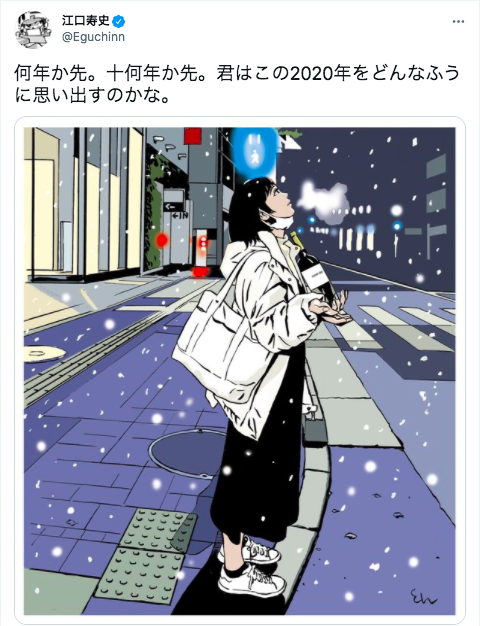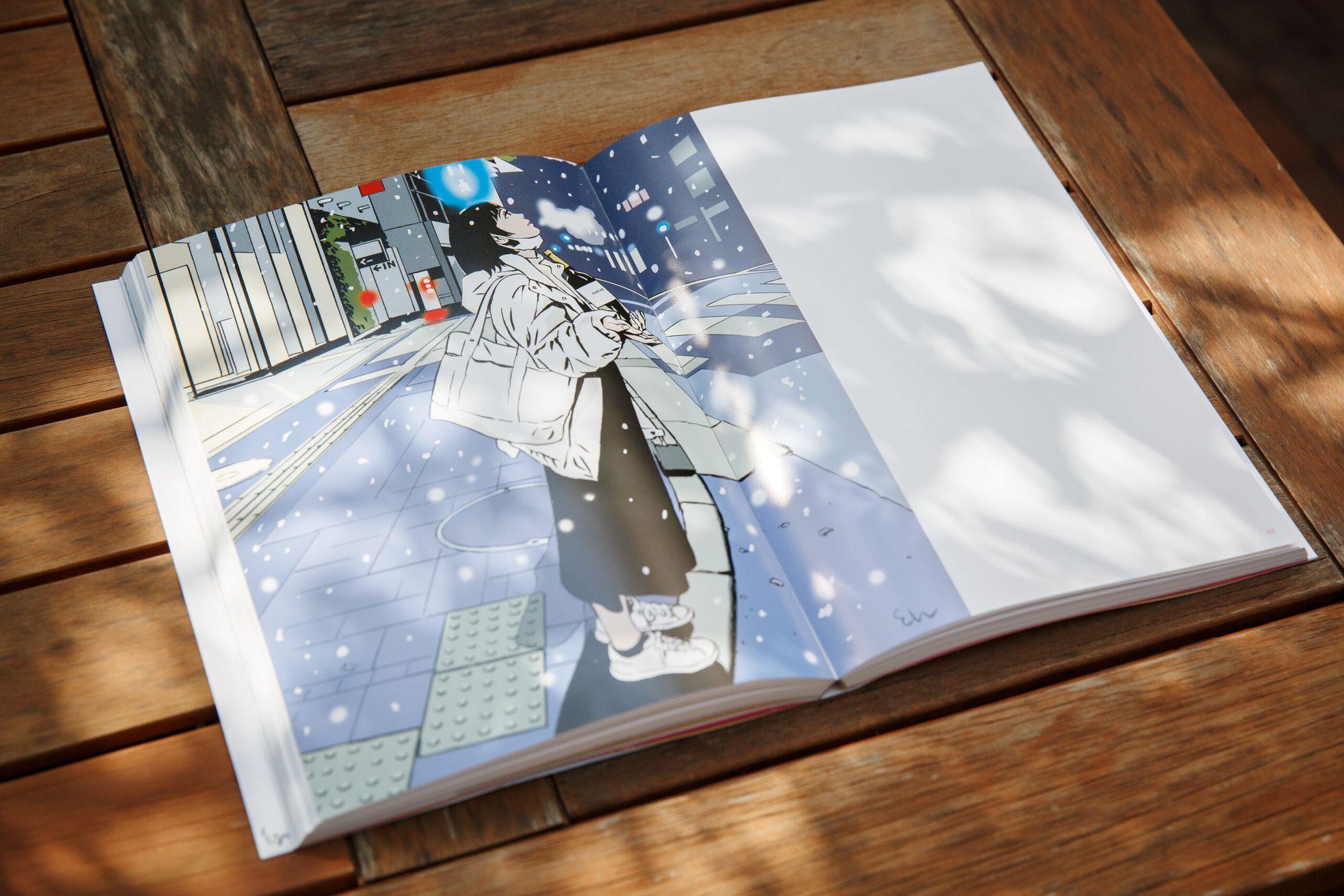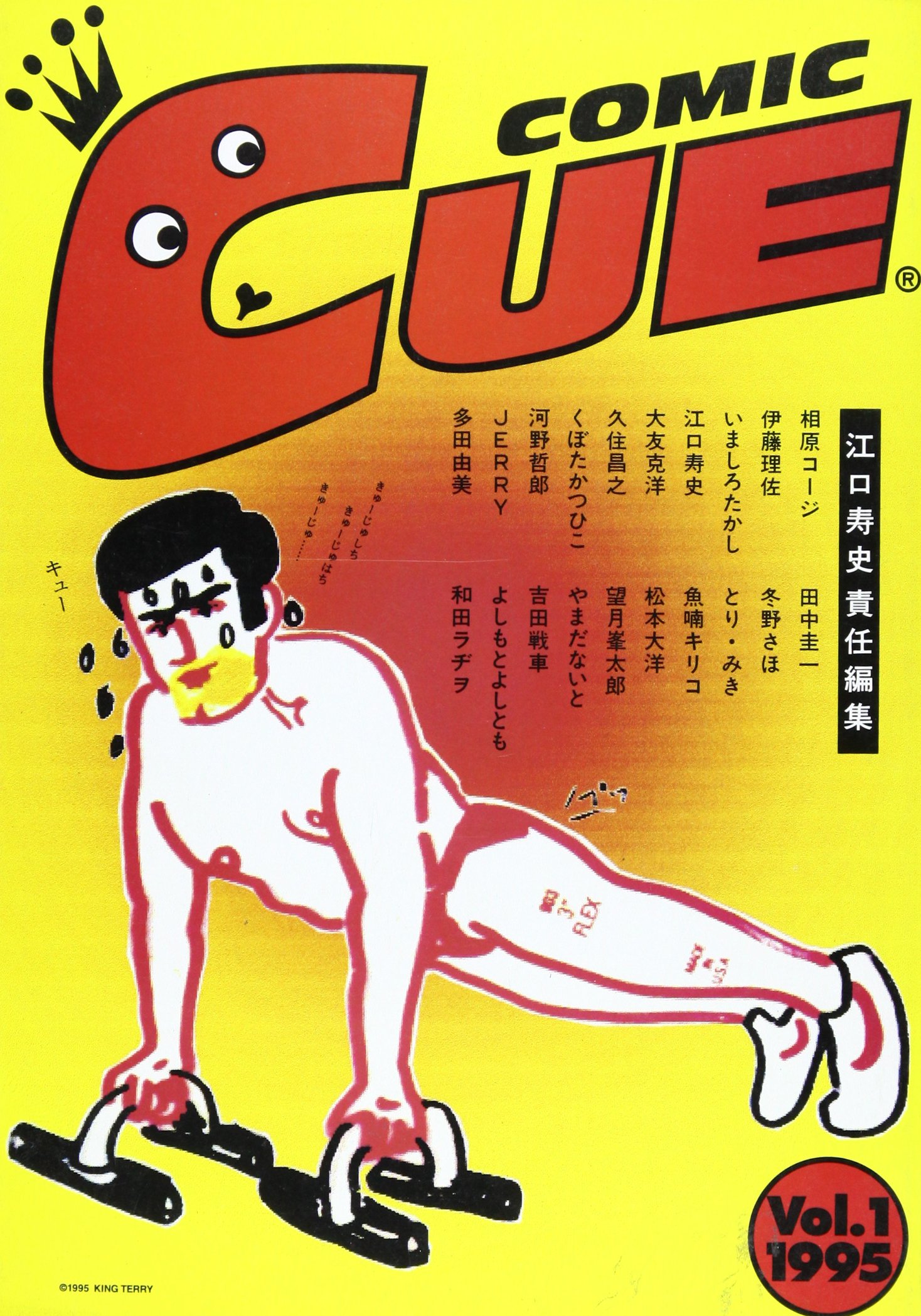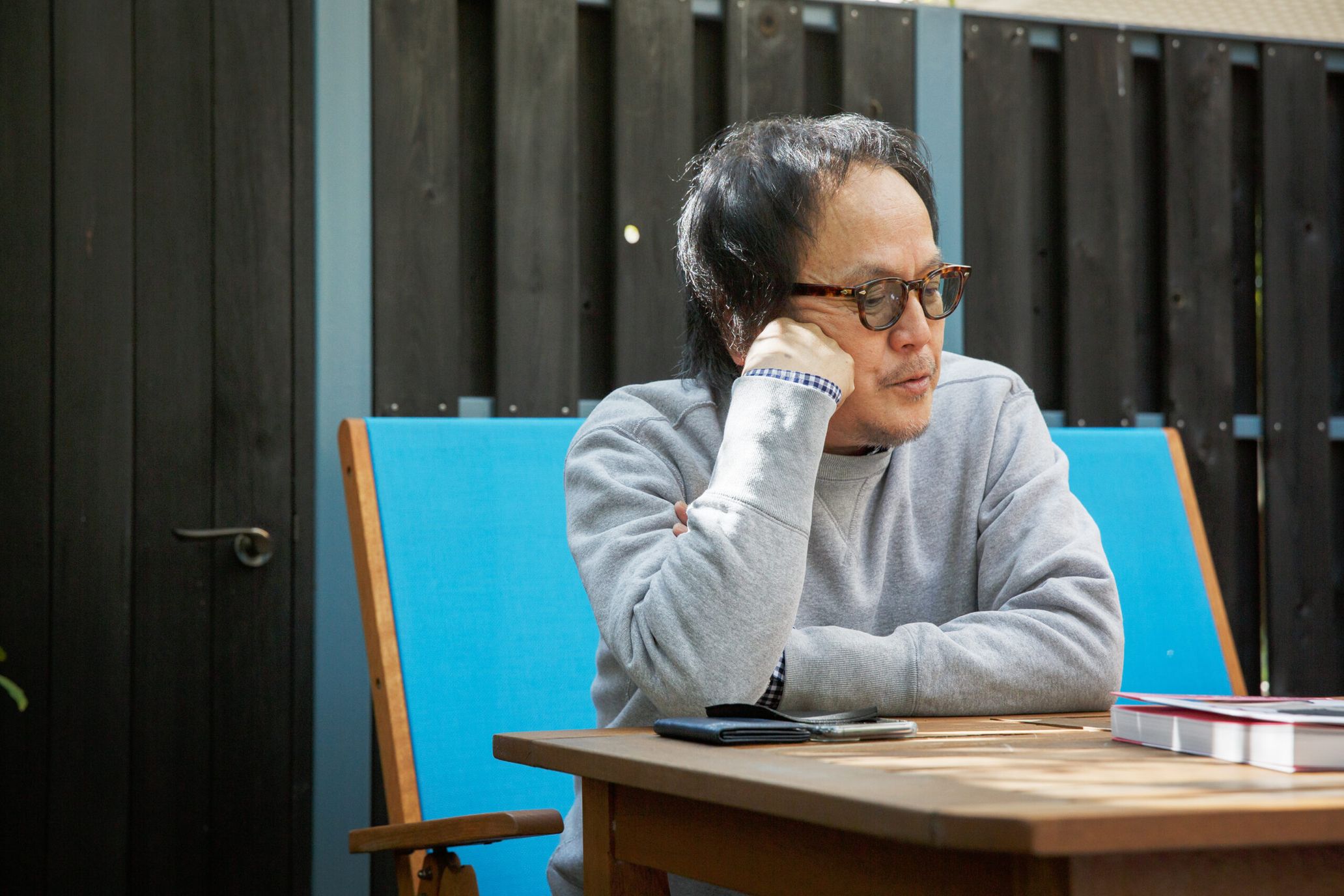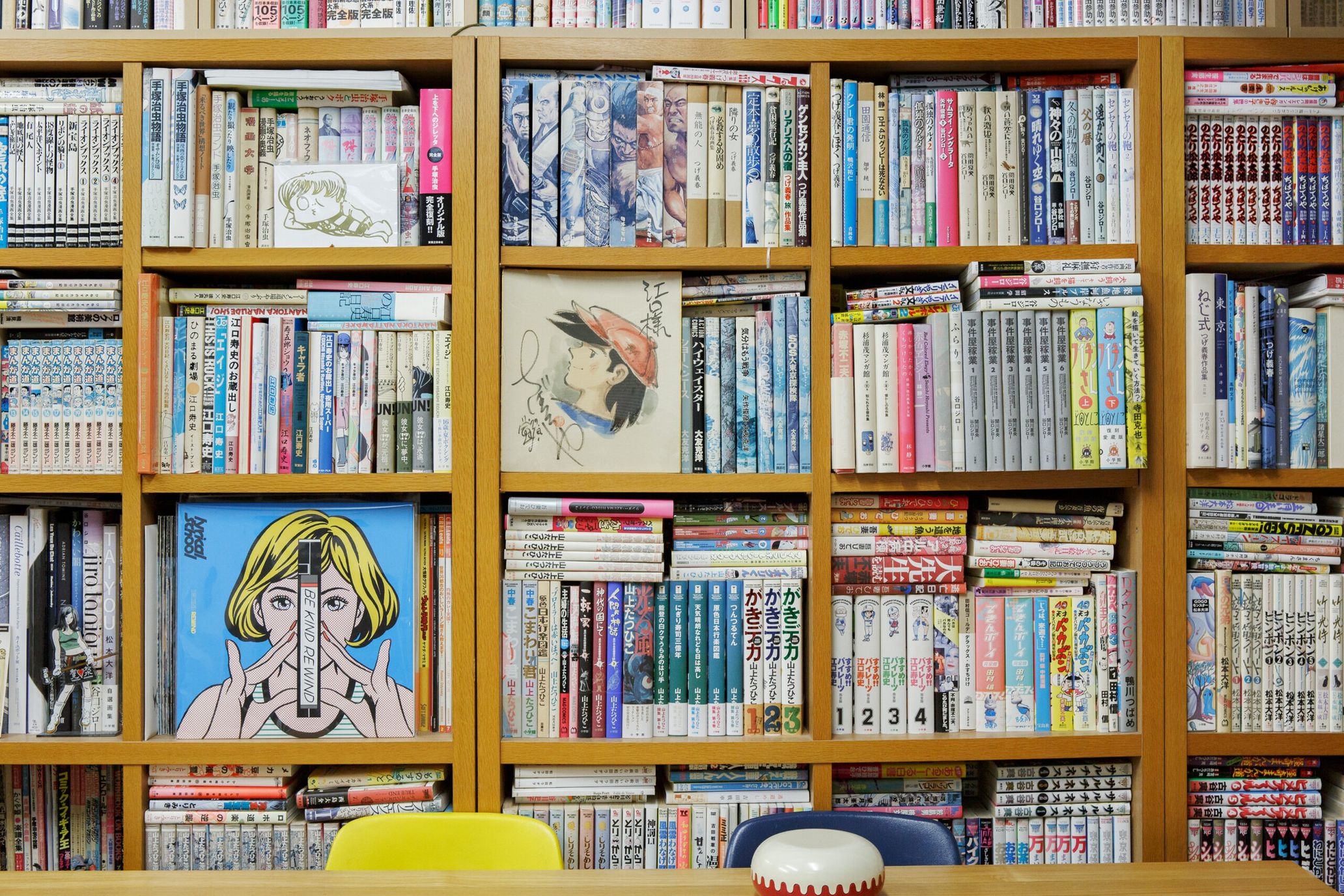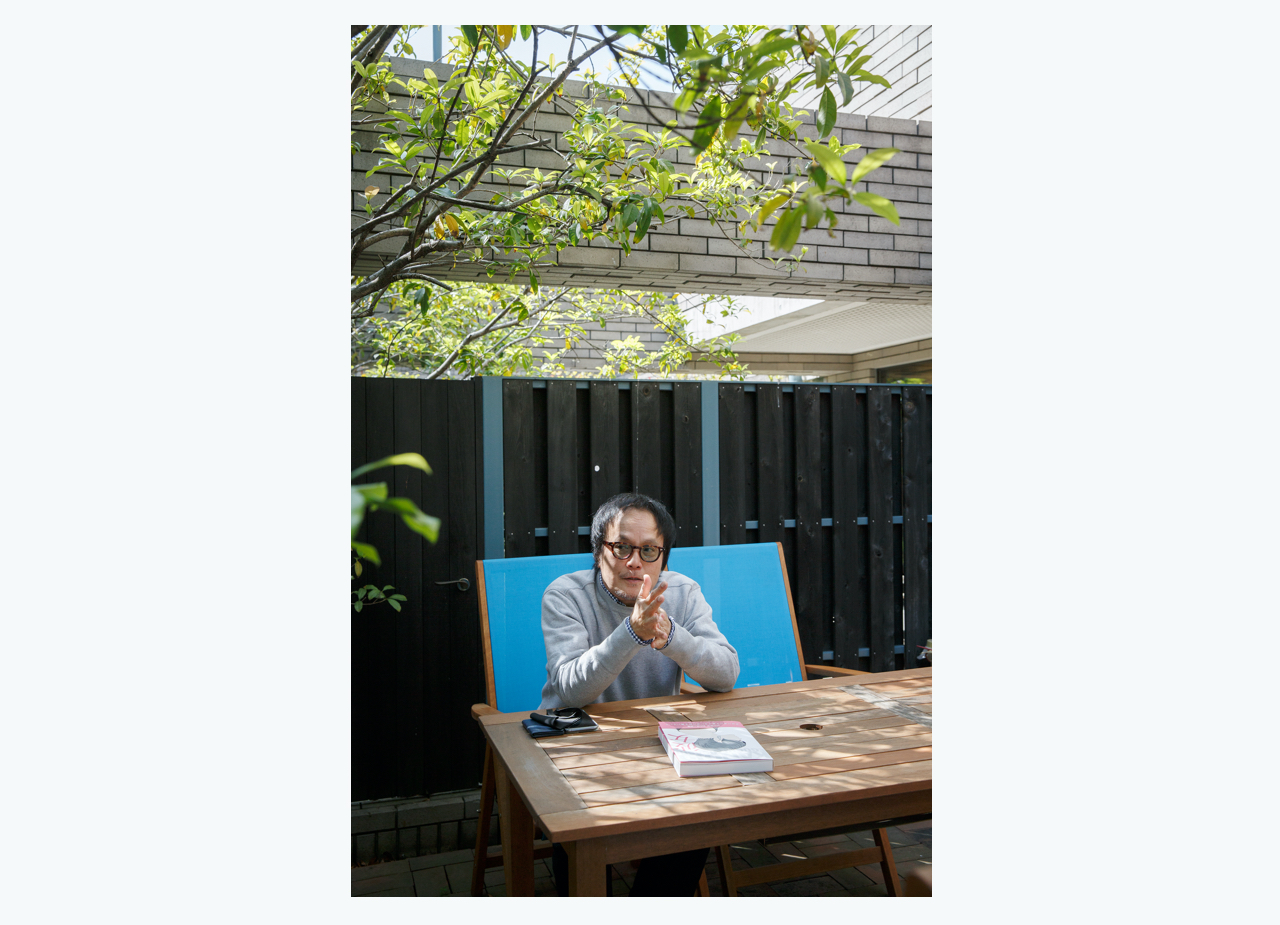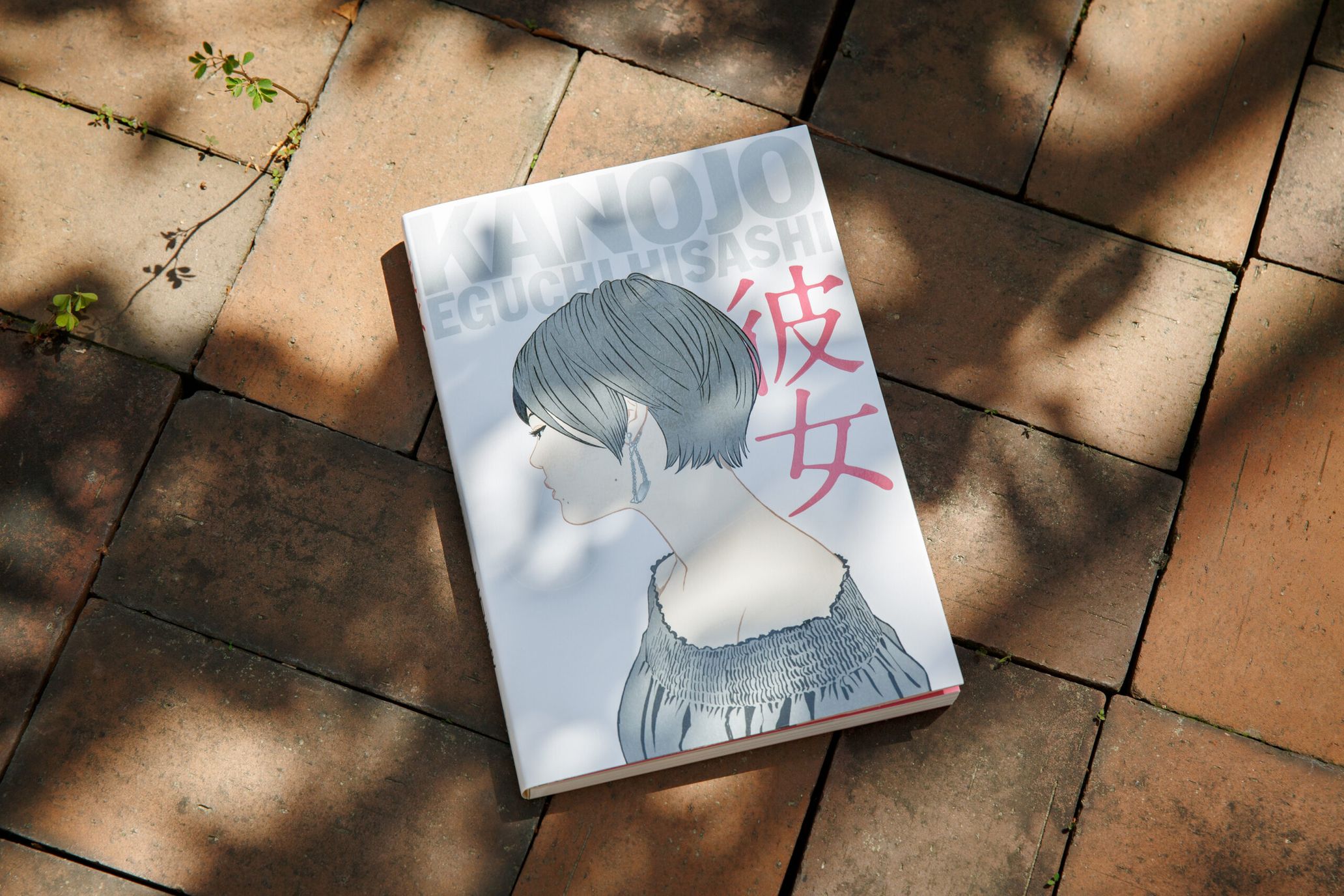Culture can be born out of a specific time and place, and yet, it possesses the ability to become timeless. In this series, “時音” TOKION invites people who are shaping culture today, to talk about the past, present, and future.
This time, we interviewed Hisashi Eguchi. Eguchi is known chiefly as a manga artist and remarkably known as an illustrator who draws female characters or what he calls “Kanojo (She).”
For those who recognize him as a manga artist, you would probably know that he is a top-class procrastinator in Japan who has an infamous record of pausing many of his serialized works. Stop!! Hibari-kun!, one of his notable manga works serialized in Weekly Shonen Jump and adapted into a TV anime show, was one of his works that had gone on hiatus multiple times. The hit manga is a miracle that managed to finish the story after a long break of 27 years.
Outstanding illustrations. Witty humor. Unpredictable, thrill-inducing twists and story settings. The uncertainty of whether the next episode would come out next week. And the miracle of the final episode that may not come out but maybe yet to come. Hisashi Eguchi’s rom-com and jokes are so addictive that you will never get over it once you are into it. His works are complexly alluring. Eguchi is, in fact, not a sloth that is utterly careless about procrastinating or pausing his works. On the contrary, he is brimming with energy and avidly looking for quirky, weird ideas to amuse the readers. We visited his atelier in Tokyo to talk to and hear the thoughts of this enigmatic genius.
The illustration and tweet Hisashi Eguchi posted on his Twitter during the pandemic
“Couple years later. A decade later. I wonder what you would remember from the year 2020.”
Left with those words, she looks up at the fine snow that has just begun falling. She has a wine bottle in her hand. Maybe she is going to relish it later. Or perhaps it is a gift to someone. If it is a gift, I wonder who will be receiving it. The illustration provokes my imagination. Moreover, her white breath melting into the winter night sky and the white mask on her chin left a strong imprint on me.
From what I’ve noticed from my perspective, Hisashi Eguchi usually does not portray any details representing specific times or epidemics in his illustrations. Hence, women in his works are ever beautiful and captivating, and they never appear archaic. However, in this illustration, he deliberately (or not) drew a white mask on the girl. When I saw this, I sensed that there was some kind of a strong message that he desperately wanted to convey, even if that deviated from his usual style. This illustration can also be found on P.163 of his recently published illustration book, Kanojo.
She, a beauty, is looking up at the snow that has just begun to fall
The truth behind the white mask on her chin
――I wanted to ask you this first—why did you choose that illustration for the tweet on December 14th, 2020?
Hisashi Eguchi (from hereunder, Eguchi): No, it’s not like that. I didn’t pick the illustration for the tweet. It’s the opposite. I came up with the tweet that goes with the illustration.
――I don’t think I’d ever seen you tweet an illustration paired with a caption.
Eguchi: Well, it’s been an insane year. Value and lifestyle have changed entirely, and every day was bleak; however, the view of snow falling from the sky was still beautiful. When I uploaded that picture, it created a ripple effect, and I received many comments saying, “I love this” or “This made me teary-eyed,” yet there were also comments like, “mask-under-chin is no good.” Receiving the latter comment reminded me how it’s become a world where people can easily wield justice at you. But, that girl in the illustration, it’s not like she always has her mask under her chin. Instead, it’s a picture of a girl in a quiet, empty city, seeing fine powdery snow falling from the sky, pulling her mask down for a moment, and breathing deep and being like, “How beautiful,” despite the current circumstances of the world. I wanted to share that sentiment with people. You get it, right? That kind of brief emotion.
――Also, regarding the girls you draw—take, for instance, the ones in your collection books like KING OF POP and RECORD—they don’t seem to reflect the times or trends of the times. In movies, if a mobile phone or a character wearing a shoulder-padded jacket appears on the screen, you can inevitably tell when the film is from, but age and time don’t show in the girls you draw. Again, though, for this illustration, I thought the mask on the girl would be the decisive factor that specifies the current time.
Eguchi: That’s right. At that time, I had decided to draw the mask on the girl. In this uncertain world, I thought I had to draw a girl with a mask. I want to note that in the cap (tweet,) I wrote, “a decade later” and not “decades later.” If you say, “decades later,” it sounds like the girl will be a grandmother when she reminisces the moment. I wanted the girl to stay the way she is when she looks back at this moment—so I can say that this illustration is specific to the time of the coronavirus.
――I thought so. Nothing like that picture embraces us while reminding us that the time is real without being political. Personally, it captured my heart the way it did when I finally got to read the final episode of Stop!! Hibari-kun!, which came out after years of hiatus.
Eguchi: I’m sure in this time of Covid, everyone is going through each of their things.
――I agree. Now, please allow me to ask you some questions about your other characters. In Stop!! Hibari-kun!, including Hibari-kun, Tsubame, and Suzume, the characters’ outfits change constantly. However, in mangas of other writers, the clothes of the heroines (for example, Shizuka from Doraemon, Sally from Sally the Witch, Arale from Dr. Slump) don’t change so that these characters would be identifiable. So, how much of the trend of the time is reflected in Stop!! Hibari-kun!? Like with your illustration works, were you cautious when portraying things that may mirror a specific time and trend, such as the characters’ hairstyles, accessories, and mobile phones? And were you carefully choosing what to draw and what not to draw?
Eguchi: I do draw characteristics and fashion of the time, but nothing so dramatic, like shoulder-padded jackets and stuff like that. Even to this day, I try to draw only the basic items. By the way, I think the fashion trend is pretty much about sizing. Old clothes could look fresh and modern if you alter the size. Once, I was commissioned to draw an office lady for a business magazine cover and drew her wearing a shoulder-padded jacket, which was in at that time. Other than that, I’ve never deliberately drawn characters in that type of clothes.
――Actually, I think there’s one thing that isn’t quite contemporary— we never see thongs in the up-skirt, panty-shot scenes in Stop!! Hibari-kun! Nowadays, thongs are more common and becoming standard underwear.
Eguchi: Ah [laughs]. I’ve never cared much about underwear. Though, I’m aware that there’s a long story behind the evolution of underwear in the world of manga. I’ve never paid attention to underwear, but I was amazed by how Tatsuo Kanai (creator of Hole in One published in Weekly Shonen Jump) and Masakatsu Katsura (creator of Wing Man published in Weekly Shonen Jump) were very particular about it. Out of the many, I think Tsubame Kamogawa (creator of Macaroni Horen-Sou published in Weekly Shonen Champion) was the first person to draw a particular pair of underwear. I was shocked when I first saw his character wearing a patch of cloth as underwear.
――Hearing your stories, it seems like you’re enjoying your works as well as the works of other writers.
Eguchi: Before, I had never really put my emotions into drawings. I’d thought that I should always draw with an editor’s perspective for my illustrations and manga. I was putting different references or arrangements together and created things by sampling them together. But, quite recently, I’ve started putting my emotions into my drawings. I try to capture fashion, details, and intangible things like feelings, thoughts, and smell wafting in the air. I think that’s been a change in me.
So, I think that’s why I drew the illustration of the girl with the mask. I’ve never drawn anything like that in the past—An image with my feelings infused in it. Honestly, I’ve always loved the art of embedding emotions in drawings, but I used to get shy doing so and cover it up with a joke. But that’s changing now.
――I see. In Stop!! Hibari-kun!, in the middle of some cool profound moments, the characters randomly get undressed. So, from those scenes, I was surmising that you are a bold type, not hesitant to make the characters take their clothes off; therefore, I thought you were the total opposite of a shy person.
Eguchi: I had been able to do those things because my feelings weren’t there in the drawings. I was deciding, like, “I should make it this way to make the story more entertaining.” I was always choosing the most effective ways to surprise the readers.
――So that’s what you mean by “a perspective of an editor.”
Eguchi: That’s right.
――And does this lead to becoming the editor-in-chief of COMIC CUE, which you started in 1995?
Eguchi: I started COMIC CUE as if I were creating my best music playlist. I wanted to make a book gathering all my favorite manga artists into one. However, I wasn’t qualified to do such thing. I resigned after Vol.3 because, you know, I started getting jealous of other writers as I was a writer myself [laughs]. Also, I hated making phone calls to writers, reminding them of the deadline, since I knew how they would feel, which was my weak point. And because of that, one of the writers missed the deadline, and that incident struck me hard and made me realize, “I can’t believe I’ve been doing the same thing to the editors.” I had learned that I’m not cut out to be an editor.
――In the past, you’ve mentioned that after Eiji and around Paparinko Monogatari, you started drawing nostrils on characters. For the girls in Kanojo as well, all the girls you draw are cute. Anyway, in that same interview, I was awed by the part where you explained that Katsuhiro Otomo‘s girls started to look cute after he began drawing nostrils on them. But it was unfair for you, as your girls had to look cute from the very beginning.
I think it’s hilarious how you poke fun of Mr.Ohtomo and Seizo Watase and other eminent manga artists: For example, you jokingly make fun of Fujiko Fujio, Yasuyuki Kunitomo, Sensha Yoshida, Kazuo Umezu, Hideo Azuma, and Koji Aihara, in Okuradashi Yoruyou Super, and Masami Kurumada and Ryoichi Ikegami in Stop!! Hibari-kun! What kind of relationships do you have with these artists? Or your relationships with them don’t matter, and making fun of them is what a bona fide comedy manga artist does.
Eguchi: I admire all the artists mentioned. I don’t know them all, but I tend to pick on the things that I find interesting or funny and brings me love and a smile to my face.
I love Seizo Watase, but I was picking on him as I think it’s my job as a comedy manga artist to react like a straight man and say, “No way!” to the surreal worlds he creates [laughs]. I’m also a massive fan of Ikki Kajiwara and his works, but I made fun of him a lot in Susume!! Pilates. But to be clear, I tease them only because I admire them. And I believe Mr.Kajiwara knew that.
――Nowadays, most of the things we see happening are planned or scripted. But the way you pick on other writers is deviating from that modern tendency; it seems like you’ve been making jokes about them freely without considering the repercussions.
Eguchi: Ultimately, I see things from a reader’s perspective. I ‘m honest about what I think as a reader. So that is why I point out odd parts I find in other mangas. It’s okay if people make fun of me for missing deadlines; in fact, I should accept people making jokes about me, too.
――Have you been picked on before by other writers?
Eguchi: Yes, I think many times. For example, when I was mainly writing comedy mangas in the early days, Yude-chan (=Yudetamago: Creator of Kinnikuman (Muscle Man) published in Weekly Shonen Jump) was always picking on me. It’s because he saw me making fun of my mentor Hiroshi Motomiya, even though I was a novice at that time—I was a bad example to him [laughs].
――Now back to your illustrations. You draw cute girls standing in the middle of a city or natural scenery. Through the process of drawing girls, have you ever become interested in cameras and photography? As I believe there’s a connection between the act of drawing and the act of taking pictures.
Eguchi: I always take pictures before drawing. So, when I was young, I used to buy SLR film cameras. But the thing is that I can recreate the images in my head well by drawing, but not by photography. So, I’ve realized that I’m intrinsically better at drawing than photography.
――Would you say there are characteristics that only you see in the timelessly cute, beautiful girls you draw in Kanojo?
Eguchi: Likewise, with the view of a city, beauty is something that vanishes eventually. So, I guess, I want to capture gleaming moments of youth as they ultimately disappear. That’s it.
――You admit that you are a desperate man who has a strong will to draw more cute moments. I read an article where you spoke about your underlying desire and revealed, “I wanted to be born a girl!” So, if you were born a girl, what kind of girl would you be? If you were a girl character in your work, would you be the type who wears a short skirt and does not mind any panty shots or cleavage shots?
Eguchi: Yes, that might be it [laughs]. I wanted to be born a cute girl and be a manga artist. And be unnecessarily sexy and cutesy at meetings with editors [laughs].
―― “Burriko (girls who act cute)” is a word you coined in your manga. By the way, I’ve noticed that the girls you draw don’t have, what people generally call, a body of a model.
Eguchi: It’s the same with fashion. I prefer drawing ordinary girls you normally see out there wearing casual clothes, and not like those high-fashion models.
Thoughts, not as an illustrator, but as a manga artist leaving a mark in history
――You’ve written copious comedy mangas, left some unfinished titles, documented invincible cuteness of girls like what we see in Kanojo, and experienced being an editor-in-chief. Is there any chance that you might start an illustration series with your will? Are there any works you’d like to leave as a legacy?
Eguchi: When I was young, I didn’t think I’d still be drawing girls at this age. I thought that I would still be writing a comedy manga. Even to this day, I want to continue writing manga, and that’s why I can’t cross out my title as a manga artist on my profile. It’s just that writing manga is tough…. The assistants would draw the background sceneries, but instructing them like, “Do this here. Do that there” makes me uncomfortable, so I prefer working on my own. But it’s also really hard to do these things alone.
――When I read your past interview and conversation articles, a lot of your words resonated with me. For example, you were saying things like, “Deadlines themselves aren’t painful, the fact that there are deadlines is painful,” and “But, because I want to draw pictures that look right, a period of one week is never enough.” And I respect how you honestly tell people when you can’t get your work done on deadline, although it’s something you want to avoid.
Eguchi: Before, I wanted to make the illustrations of my manga look the same as my illustration art. But I’ve realized that it would be hard to follow the story if I made all the drawings in manga the same as my illustration art. The illustrations in manga can’t be eye-catching and hamper the storytelling. With manga, the readers need to keep moving their eyes to understand the story. So again, the drawings in manga need to be different from illustration artworks. And manga has its own power. So, I now know that I don’t need to make the drawings in manga look like illustration art; I feel like I might be able to start writing manga again.
――In “The SEX And The CITY” in Okuradashi Yoruyo Super, there are no speech bubbles at all, and no characters like the girls in Kanojo, and the stupidity of the jokes crack me up. I would love to read that type of poignant comedy manga again.
Eguchi: I love stupid mangas in general. There aren’t that many comedy mangas these days, but I would love to read some. Frivolous things are great. Manga by Tatsuhiko Yamagami (creator of Gaki Deka published in Weekly Shonan champion) and Fujio Akatsuka made me laugh, which saved me a lot, and I was aiming to create comedy manga like theirs. It just feels great to laugh.
――Your manga, like the aforementioned “SEX And The CITY” saved me, too. It’s incredibly perverted and obscene, but it’s funny and warms my heart.
Eguchi: I would love to portray the stupidity of humans again.
――By the way, I feel like some phrases and expressions in Stop!! Hibari-kun! wouldn’t be acceptable these days.
Eguchi: It’s full of controversial remarks. A lot of them are not acceptable anymore. I wasn’t trying to insult anyone back then, but it would be hard for people to assimilate them as jokes now.
――Now back again to Kanojo. In which season do you like drawing the girls? Also, any specific settings you like drawing?
Eguchi: When I was young, I definitely loved summer the most. I loved the summer island beach. But nowadays, I really like the transition from autumn to winter. Maybe it’s because of my age. Instead of the freedom of summer, I’d rather prefer drawing sentiments like the comfort of wrapping a scarf around your neck as the cold winter approaches. Actually, I recently drew a summer island and a beach for the first time in a while, for the collaboration project with Eiichi Ohtaki, for his album A LONG VACATION 40th Anniversary Edition. I recreated the summer scenery I’ve always had in my head since the time I was listening to the original version of the album: A small island in Okinawa, a narrow white road, and a vast coral reef beach beyond the road.
――What about the summer in the cover art of Takuro Yoshida’s Isshun No Natsu?
Eguchi: For that, I wanted to draw the signage of Hyakkaen. Beyond Hyakkaaen, there’s a sky and clouds, which exude a mature emotional vibe. It’s like nostalgia in the middle of an urban city. I’m glad I drew the signage as it doesn’t exist there anymore.
――Hearing your stories makes me want to look at your works once again to see the sonic afterimages, or in other words, the nostalgic views that you convey inspired by the music.
Eguchi: I think I’ll be drawing more things like that. I feel so myself.
――Such things as the imagined and real sceneries in Japan that are bound to fade away?
Eguchi: Well, now, I’m pretty busy drawing illustrations of girls. Naturally, though, I will draw different types of things if I get various kinds of requests. But, of course, I always try to be careful not to plagiarize from myself.
――So now you’re mostly getting illustration job offers? Are you busy for a while?
Eguchi: Yes. Now it’s 100% illustration jobs. I’m not getting any manga job offers [laughs]. If I wanted to work on a manga, I would have to do it by myself and take it to the publisher and ask them to publish it.
A B4 size paper lying on a table. Manga artist Hisashi Eguchi has always drawn illustrations with panel layouts on a big sheet of paper, an A3 size. Ever since he expanded his career as an illustrator, his artworks have become ubiquitous, which probably almost every nation has seen at some point. The largest illustration he’s ever drawn out of his career was a 180cm x 180cm size live painting. This time, interviewing the artist had driven me to imagine what kind of mural this artist—who preciously captures the smell of the city and seasons and girls in cities—would paint if he were to paint on an enormous wall in town. The curiosity sparked in me as I caught the pure mind of the prolific manga artist and illustrator, intrinsically seeking to document funny and beautiful things without being swayed by age or career. If this man did sessions with younger talents, there would be great legacies left in Japan. In Tokyo—I was convinced.
“Couple years later. A decade later. I wonder what you would remember from the year 2020.”
We can’t predict the future and where this pandemic is going, but I can say that mesmerizing creations will never be affected by the virus but remain quietly yet powerful in our world. After this interview, I perceived the smell of emotions and times that Eguchi was talking about, from the girl facing sideways, pulling her mask down to her chin, and taking a deep breath for a moment.
Hisashi Eguchi
Born in 1956. He is a manga artist and illustrator from Kumamoto-prefecture. In 1977, he won the Weekly Shonen Jump Newcomers Manga Award for Osorubeki Kodomotachi. He debuted as a professional manga artist with Hachi-jihan no Ketto, his work nominated at the 6th Akatsuka Award. His best-known works include, Susume!! Pilates and Stop!! Hibari-kun! He won the 38th Bungeishunju Manga Award for Hisashi Eguchi’s Dynamite Dinner Show, a collection of short stories published in 1991. He founded and became editor-in-chief of COMIC CUE in 1995, gathering illustrious manga writers such as Taiyo Matsumoto and Minetaro Mochizuki, and experienced the role of “forcing deadlines to writers,” which is the opposite of his usual position of “being forced to follow deadlines.” He is a phenomenal manga artist well-known for his original sense of humor, remarkable drawing skills, and pausing many of his serialized works. He is also a sought-after illustrator who has accomplished corporate tie-up projects and one-and-only record cover arts.
After publishing the collection book, KING OF POP (published by Genkosha) in 2015, he opened the illustration exhibition KING OF POP at eight different locations in Japan. From 2018 to 2019, his illustration exhibition, Kanojo, was held at three art museums in Japan, first opening at the 21st Century Museum of Contemporary Art, Kanazawa. However, the exhibition was suspended due to the coronavirus pandemic. However, in 2021, after releasing the collection book Kanojo, the exhibition reopened in Aomori-city and Asahikawa-city, where the artist performed live painting for the first time on a large canvas and attracted many fans and earned great responses. As written on the book band of his latest collection book, Kanojo, he is a highly lauded artist who draws illustrations of Kanojo (“She”) that no one in the world can ever draw.
Twitter:@Eguchinn
Instagram:@egutihisasi / @eguchiworks
■Kanojo (2021)
Author: Hisashi Eguchi
Publisher: Shueisha International
Photography Takeshi Abe
Translation Ai Kaneda


